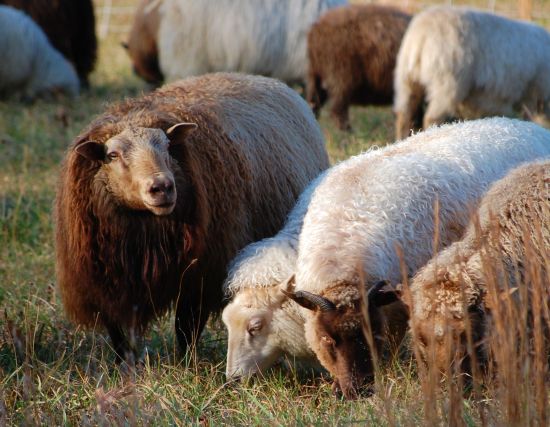
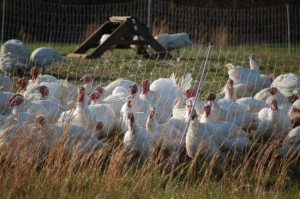 Our Thanksgiving turkey is walking and talking less than a quarter mile up the road. She is ranging around in a big pasture with a few hundred friends, enjoying the fresh grass, salt air, and rosy sunsets of rural West Tisbury. Even closer, a few paces down the road in the other direction, tasty lamb shanks graze in a spent hayfield. I drive by them every time I leave the house. Of course, I don’t necessarily think “rosemary and garlic” when I look at them. I think about how gorgeous their chocolate and cream-colored wool is and how funny their faces are, with their feral eyes and grinding jaws and devil’s ears. Baby lambs are cute; adult sheep can actually be sort of strange looking.
Our Thanksgiving turkey is walking and talking less than a quarter mile up the road. She is ranging around in a big pasture with a few hundred friends, enjoying the fresh grass, salt air, and rosy sunsets of rural West Tisbury. Even closer, a few paces down the road in the other direction, tasty lamb shanks graze in a spent hayfield. I drive by them every time I leave the house. Of course, I don’t necessarily think “rosemary and garlic” when I look at them. I think about how gorgeous their chocolate and cream-colored wool is and how funny their faces are, with their feral eyes and grinding jaws and devil’s ears. Baby lambs are cute; adult sheep can actually be sort of strange looking.
Cuteness factors aside, we are really fortunate to have uber-local, humanely-raised (delicious) meat available to us. And even though we can see how these animals are raised, they’re still living on our neighbors’ property—not ours—so we don’t have to deal with the whole personality issue. Yet.
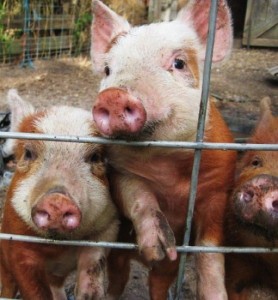 Yesterday I was staring into the face of a charred pig with a spit in his mouth. It was the second Island pig roast we’ve been to in the last few weeks. As Libby and I nibbled on a particularly sweet and juicy hunk of pork, I said to her, “Do you really think we could do this—raise a pig and then eat her?” Libby just sort of giggled nervously. This is a girl who pays attention to what’s going on around her, and she knows. Knows how most meat animals in this country are raised (heard me talking about it enough) and knows what humanely raised animals look like (dozens of visits to Island farms, don’t you know). And she understands the difference between a farm animal (one that you spend lots of time and money feeding and watering in order to get a certain return on it) and a farm pet (like our dog Farmer, whose sole purpose in life is to be cute and provide lots of kisses and snuggles on the couch—and to chase chickens).
Yesterday I was staring into the face of a charred pig with a spit in his mouth. It was the second Island pig roast we’ve been to in the last few weeks. As Libby and I nibbled on a particularly sweet and juicy hunk of pork, I said to her, “Do you really think we could do this—raise a pig and then eat her?” Libby just sort of giggled nervously. This is a girl who pays attention to what’s going on around her, and she knows. Knows how most meat animals in this country are raised (heard me talking about it enough) and knows what humanely raised animals look like (dozens of visits to Island farms, don’t you know). And she understands the difference between a farm animal (one that you spend lots of time and money feeding and watering in order to get a certain return on it) and a farm pet (like our dog Farmer, whose sole purpose in life is to be cute and provide lots of kisses and snuggles on the couch—and to chase chickens).
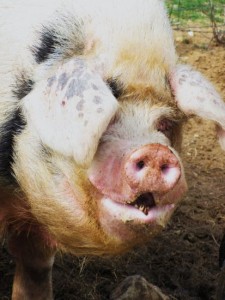 But still she is an animal lover. And she is 10 years old. I, on the other hand, am not 10. So I’m not sure what my excuse is. I’m just awfully afraid that we’re going to get piglets (already in the works for next spring) with the intention of raising them to slaughter weight (sometime next fall) but wind up with a couple of 600-pound sows (a decade from now) that have become the hugest hungriest farm pets ever. I keep thinking of James Taylor’s song about his pig, Mona, who he bought expressly to raise for meat and never was able to slaughter. “Mona, Mona, so much of you to love, a little bit too much of you to take care of.” This famous pig actually lived on the Vineyard. Some of my friends remember her. And she was huge.
But still she is an animal lover. And she is 10 years old. I, on the other hand, am not 10. So I’m not sure what my excuse is. I’m just awfully afraid that we’re going to get piglets (already in the works for next spring) with the intention of raising them to slaughter weight (sometime next fall) but wind up with a couple of 600-pound sows (a decade from now) that have become the hugest hungriest farm pets ever. I keep thinking of James Taylor’s song about his pig, Mona, who he bought expressly to raise for meat and never was able to slaughter. “Mona, Mona, so much of you to love, a little bit too much of you to take care of.” This famous pig actually lived on the Vineyard. Some of my friends remember her. And she was huge.
Not eating our own pork would be hypocrisy at its worst. I am (at least I think I am) 100 percent in favor of more locally, humanely raised animals. And 100 percent in favor of eating all the parts of those animals and making that meat stretch over many meals. Choosing to eat a little less meat overall and a little more locally-raised meat are the only ways I see to help fuel the shift away from factory farms.
And I am especially excited about a movement on the Island to build a USDA-approved four-legged humane slaughterhouse. This would be a big incentive for Island farmers to raise more meat animals, because they wouldn’t have to take the animals on an expensive and stressful ferry ride to a facility hundreds of miles away (and wait weeks to get the meat back). And by definition, an Island animal is a pastured animal—there’s no such thing as a feedlot here.
Most ludicrous is the thought that I might disdain eating our own pig and then turn around and go to the grocery store and buy a package of bacon (which I will do—there is certainly no point in pretending that I will never eat bacon again). This would be like giving the factory farms a big thumbs up and poking a stick in the eye of all the efforts to return animal raising to a natural and sustainable system in this country.
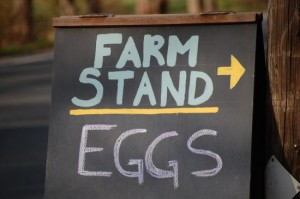 And here’s the kicker. We wanted to be farmers. So we started to grow vegetables. Then we got a few laying hens. Then we got some more laying hens. Then we decided we might actually like to get serious about farming as a small business. Then, just a few weeks ago, our landlord invited us to use the three acres of fields behind us for farming. So now we have 200 more laying hens arriving here—tomorrow. And once you decide to make eggs a business, you really have no choice but to “trade in” your hens every couple of years, because their productivity declines. It’s way too expensive (and not a smart business move) to feed hens that aren’t laying many eggs. (No matter how much pasture the hens graze on, they still need supplemental feed.) So your two-year-old hens go off to slaughter. They become chicken pot pies.
And here’s the kicker. We wanted to be farmers. So we started to grow vegetables. Then we got a few laying hens. Then we got some more laying hens. Then we decided we might actually like to get serious about farming as a small business. Then, just a few weeks ago, our landlord invited us to use the three acres of fields behind us for farming. So now we have 200 more laying hens arriving here—tomorrow. And once you decide to make eggs a business, you really have no choice but to “trade in” your hens every couple of years, because their productivity declines. It’s way too expensive (and not a smart business move) to feed hens that aren’t laying many eggs. (No matter how much pasture the hens graze on, they still need supplemental feed.) So your two-year-old hens go off to slaughter. They become chicken pot pies.
Ah. It appears we have already crossed the line into raising animals for meat. Making the leap from a chicken to a pig shouldn’t be that hard, should it?
 P.S. The three acres are the reason why the pigs are now a possibility. And stay tuned for more about the arrival of the 200 chickens and photos of Roy’s new coops. The chickens are 17-week-old pullets, so they’ll be ready to lay in a few weeks. We’re skipping the baby-chick phase this time, so at least we don’t have to deal with that cute fest!
P.S. The three acres are the reason why the pigs are now a possibility. And stay tuned for more about the arrival of the 200 chickens and photos of Roy’s new coops. The chickens are 17-week-old pullets, so they’ll be ready to lay in a few weeks. We’re skipping the baby-chick phase this time, so at least we don’t have to deal with that cute fest!
And thank you to The Good Farm, Cleveland Farm, and Mermaid Farm for letting me photograph their turkeys and sheep on State Road.

Love this article and appreciate your thinking about the “meat business”. I’ve only been following you for a few months, and have been wondering where you stood on that issue. I’m glad to know we think exactly alike, so even more reason to follow your recipes and spread the good word!
As for your questioning about the pigs, I would have trouble with that too. But it seems as though you are following the very best possible policy with regard to eating meat. If there is a humane slaughterhouse somewhere near (staffed by decent people who don’t take out all their anger on animals), it would seem like your animals had about the best possible life they could hope for.
Keep up the great work, Susie!
Thanks Anne. The great thing is that local, humanely-raised meat is tastier, too!
HI Susie,
During the summer I remember looking up either in your book or blog a recipe to cook Romanesco brocoli, it was simple and delicious, but today I am looking for it agan and can not find it!!
PLease help!!
thanks Talia
We buy our processed pork from a farm in Concord, MA. Been doing this for 3 years. I do know they send the pigs somewhere for butchering (maybe Maine??) So nice to have a relationship with the farmer. And be able to visit the farm and ask questions about the animals’ lifestyle and feed. They are also our source for pastured chickens.
One thing I have noticed about the chickens. They are big–around 6 lbs–and tough. (Varieties are Cornish Cross and Red Bro). I jcan’t roast them and need to introduce moisture in the cooking process. However, the pork is fatty and succulent and delicious.
But, as a meat-eater, I do want to know that the animals have been treated well.
Hi Kathy,
This is great that you’re doing this. Yes, I find “pot-roasting” the big local chickens makes them very succulent–sort of like partially covered braising with just a little liquid–delicious alternative to roasting.